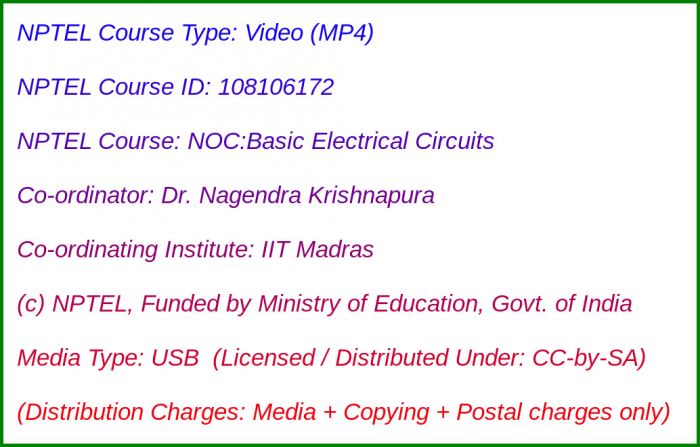
Media Storage Type : 32 GB USB Stick
NPTEL Subject Matter Expert : Dr. Nagendra Krishnapura
NPTEL Co-ordinating Institute : IIT Madras
NPTEL Lecture Count : 143
NPTEL Course Size : 3.4 GB
NPTEL PDF Text Transcription : Available and Included
NPTEL Subtitle Transcription : Available and Included (SRT)
Lecture Titles:
Lecture 1 - Preliminaries
Lecture 2 - Current
Lecture 3 - Voltage
Lecture 4 - Electrical elements and circuits
Lecture 5 - Kirchhoff's current law (KCL)
Lecture 6 - Kirchhoff's voltage law (KVL)
Lecture 7 - Voltage source
Lecture 8 - Current source
Lecture 9 - Resistor
Lecture 10 - Capacitor
Lecture 11 - Inductor
Lecture 12 - Mutual inductor
Lecture 13 - Linearity of elements
Lecture 14 - Series connection-Voltage sources in series
Lecture 15 - Series connection of R, L, C, current source
Lecture 16 - Elements in parallel
Lecture 17 - Current source in series with an element; Voltage source in parallel with an element
Lecture 18 - Extreme cases: Open and short circuits
Lecture 19 - Summary
Lecture 20 - Voltage controlled voltage source (VCVS)
Lecture 21 - Voltage controlled current source (VCCS)
Lecture 22 - Current controlled voltage source (CCVS)
Lecture 23 - Current controlled current source (CCCS)
Lecture 24 - Realizing a resistance using a VCCS or CCCS
Lecture 25 - Scaling an element's value using controlled sources
Lecture 26 - Example calculation
Lecture 27 - Power and energy absorbed by electrical elements
Lecture 28 - Power and energy in a resistor
Lecture 29 - Power and energy in a capacitor
Lecture 30 - Power and energy in an inductor
Lecture 31 - Power and energy in a voltage source
Lecture 32 - Power and energy in a current source
Lecture 33 - Goals of circuit analysis
Lecture 34 - Number of independent KCL equations
Lecture 35 - Number of independent KVL equations and branch relationships
Lecture 36 - Analysis of circuits with a single independent source
Lecture 37 - Analysis of circuits with multiple independent sources using superposition
Lecture 38 - Superposition: Example
Lecture 39 - What is nodal analysis
Lecture 40 - Setting up nodal analysis equations
Lecture 41 - Structure of the conductance matrix
Lecture 42 - How do elements circuit appear in the nodal analysis formulation
Lecture 43 - Completely solving the circuit starting from nodal analysis
Lecture 44 - Nodal analysis example
Lecture 45 - Matrix inversion basics
Lecture 46 - Nodal analysis with independent voltage sources
Lecture 47 - Supernode for nodal analysis with independent voltage sources
Lecture 48 - Nodal analysis with VCCS
Lecture 49 - Nodal analysis with VCVS
Lecture 50 - Nodal analysis with CCVS
Lecture 51 - Nodal analysis with CCCS
Lecture 52 - Nodal analysis summary
Lecture 53 - Planar circuits
Lecture 54 - Mesh currents and their relationship to branch currents
Lecture 55 - Mesh analysis
Lecture 56 - Mesh analysis with independent current sources-Supermesh
Lecture 57 - Mesh analysis with current controlled voltage sources
Lecture 58 - Mesh analysis with current controlled current sources
Lecture 59 - Mesh analysis using voltage controlled sources
Lecture 60 - Nodal analysis versus Mesh analysis
Lecture 61 - Superposition theorem
Lecture 62 - Pushing a voltage source through a node
Lecture 63 - Splitting a current source
Lecture 64 - Substitution theorem: Current source
Lecture 65 - Substitution theorem: Voltage source
Lecture 66 - Substituting a voltage or current source with a resistor
Lecture 67 - Extensions to Superposition and Substitution theorem
Lecture 68 - Thevenin's theorem
Lecture 69 - Worked out example: Thevenin's theorem
Lecture 70 - Norton's theorem
Lecture 71 - Worked out example: Norton's theorem
Lecture 72 - Maximum power transfer theorem
Lecture 73 - Preliminaries
Lecture 74 - Two port parameters
Lecture 75 - y parameters
Lecture 76 - y parameters: Examples
Lecture 77 - z parameters
Lecture 78 - z parameters: Examples
Lecture 79 - h parameters
Lecture 80 - h parameters: Examples
Lecture 81 - g parameters
Lecture 82 - g parameters: Examples
Lecture 83 - Calculations with a two-port element
Lecture 84 - Calculations with a two-port element
Lecture 85 - Degenerate cases
Lecture 86 - Relationships between different two-port parameters
Lecture 87 - Equivalent circuit representation of two-ports
Lecture 88 - Reciprocity
Lecture 89 - Proof of reciprocity of resistive two-ports
Lecture 90 - Proof for 4-terminal two-ports
Lecture 91 - Reciprocity in terms of different two-port parameters
Lecture 92 - Reciprocity in circuits containing controlled sources
Lecture 93 - Examples
Lecture 94 - Feedback amplifier using an opamp
Lecture 95 - Ideal opamp
Lecture 96 - Negative feedback around the opamp
Lecture 97 - Finding opamp sign for negative feedback
Lecture 98 - Example: Determining opamp sign for negative feedback
Lecture 99 - Analysis of circuits with opamps
Lecture 100 - More on opamps: Example circuits and additional topics
Lecture 101 - Inverting amplifier
Lecture 102 - Summing amplifier
Lecture 103 - Instrumentation amplifier
Lecture 104 - Negative resistance
Lecture 105 - Finding opamp signs for negative feedback-circuits with multiple opamps
Lecture 106 - Opamp supply voltages and saturation
Lecture 107 - KCL with an opamp and supply currents
Lecture 108 - Circuits with storage elements (capacitors and inductors)
Lecture 109 - First order circuit with zero input-natural response
Lecture 110 - First order RC circuit with zero input-Example
Lecture 111 - First order circuit with a constant input
Lecture 112 - General form of the first order circuit response
Lecture 113 - First order RC circuit with a constant input-Example
Lecture 114 - First order circuit with piecewise constant input
Lecture 115 - First order circuit with piecewise constant input-Example
Lecture 116 - First order circuit-Response of arbitrary circuit variables
Lecture 117 - Summary: Computing first order circuit response
Lecture 118 - Does a capacitor block DC?
Lecture 119 - Finding the order of a circuit
Lecture 120 - First order RC circuits with discontinuous capacitor voltages
Lecture 121 - Summary: Computing first order circuit response with discontinuities
Lecture 122 - First order RL circuits
Lecture 123 - First order RL circuit with discontinuous inductor current-Example
Lecture 124 - First order RC circuit with an exponential input
Lecture 125 - First order RC response to its own natural response
Lecture 126 - First order RC response to a sinusoidal input
Lecture 127 - First order RC response to a sinusoidal input-via the complex exponential
Lecture 128 - Summary: Linear circuit response to sinusoidal input via the complex exponential
Lecture 129 - Three methods of calculating the sinusoidal steady state response
Lecture 130 - Calculating the total response including initial conditions
Lecture 131 - Why are sinusoids used in measurement?
Lecture 132 - Second order system natural response
Lecture 133 - Second order system as a cascade of two first order systems
Lecture 134 - Second order system natural response-critically damped and underdamped
Lecture 135 - Generalized form of a second order system
Lecture 136 - Numerical example
Lecture 137 - Series and parallel RLC circuits
Lecture 138 - Forced response of a second order system
Lecture 139 - Steady state response calculation and Phasors
Lecture 140 - Phasors (Continued...)
Lecture 141 - Magnitude and Phase plots
Lecture 142 - Magnitude and phase plotes of a second order system
Lecture 143 - Maximum power transfer and Conjugate matching

